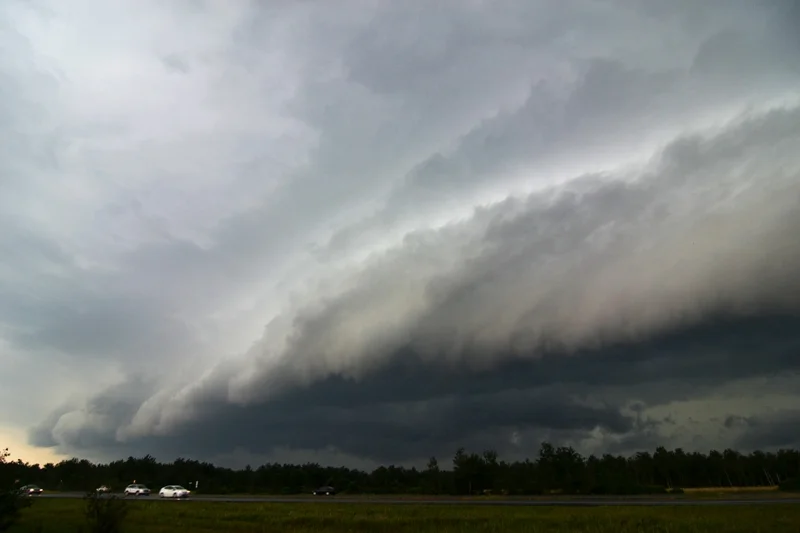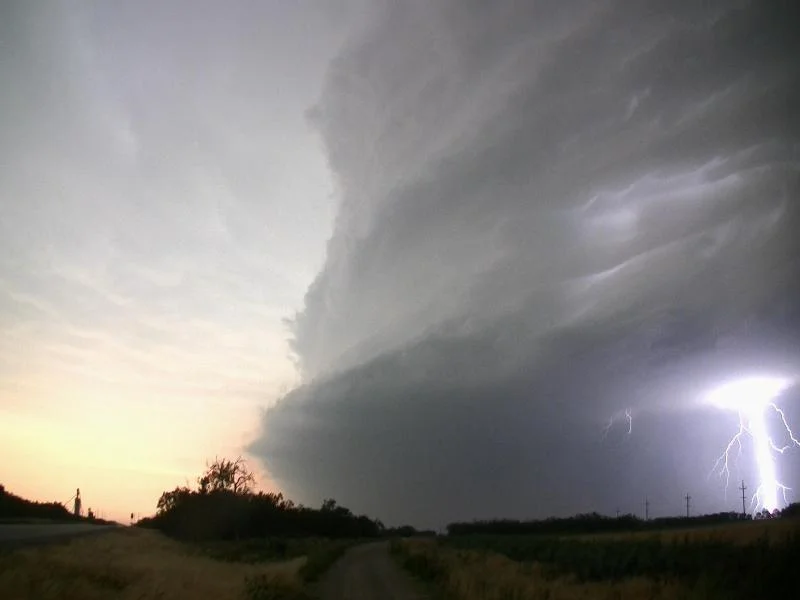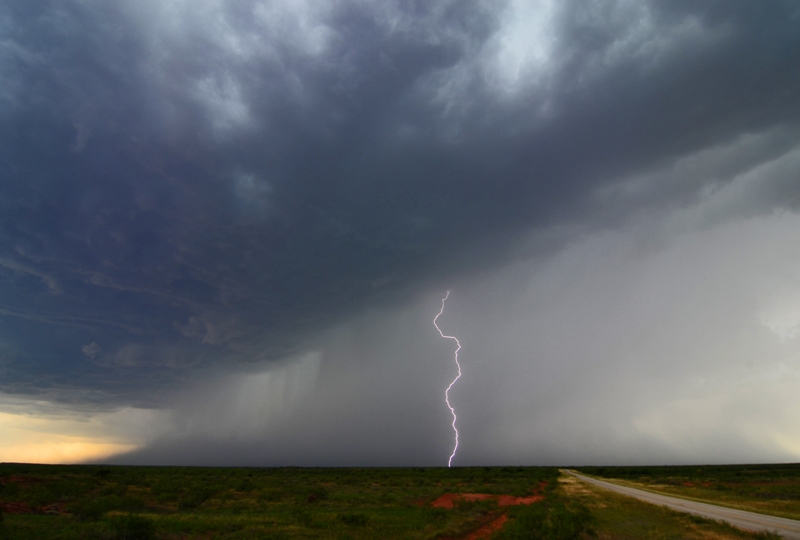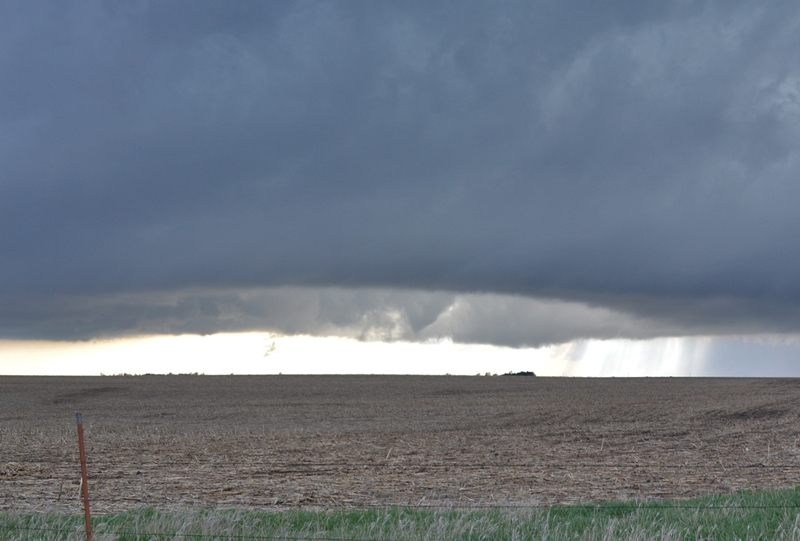05-30-2012 CHASE LOG: TEXAS
This ended up being a very good day with some forecasting challenges. We were presented with a dilemma in the morning, being torn between a target that SPC and many other chasers favored along the warm front in southern KS into northern OK, with the other target along the dryline in the eastern TX Panhandle. We favored the TX Panhandle target due to the presence of higher instability and with the moisture axis being oriented right over the area, along with a dryline in place. The better upper level support was to the north, but there was still around 50 kts of deep layer shear and very steep lapse rates in this area. The concern was that, if rich moisture could reach the warm front, storm motion would be right along the boundary and lead to a tornado threat. It became apparent as we left Oklahoma City and headed west on I-40 that the moisture was not going to be as high as the models suggested further north. We officially made up our minds towards early afternoon to head to TX as the short range model guidance was breaking out a pair of supercells in the Panhandle and we thought the better environment was in place. We headed towards the dryline, east of the Caprock, towards Memphis, TX.
At 2:58pm, a mesoscale discussion was issued by SPC for an area of northwest TX in our target zone. This discussion highlighted the corridor of strong instability, as noted by the 2500-3500 j/kg of MLCAPE up through the area, with surface dewpoints in the mid 60s, and steep lapse rates near 8.0 C/km. This also noted the wave clouds that we noticed upon driving to our target area, suggesting the environment would be more stable further to the east. Shortly after 4pm, supercells exploded on the dryline near and east of the Caprock in the eastern TX Panhandle, while a Tornado Watch was issued for the area at 3:40pm. We were on our first storm near Memphis, which had a large rain-free updraft initially and a pair of long inflow bands feeding into the storm. We were able to sit and watch this storm for a half hour before the lightning threat became too great and we were forced to bail south on Hwy 287 towards Childress. We had to watch a storm to our south that had unimpeded inflow and was in danger of cutting off the inflow into our storm. However, our storm continued to look good as it produced numerous shear funnels and awesome corkscrew structure with strong inflow sucking in red dirt right into the updraft base. The inflow had to be around 50 mph INTO the storm at times as we progressed into Estelline and decided to head west around the mesocyclone on Hwy 86. We watched as this storm neared, but quickly turned back and almost got cut off by huge hail, some that started to fall as we neared Estelline and bailed south again on Hwy 287. This was where we put a few more cracks in the windshields due to the hard golf ball or larger sized hail that was falling. We got out ahead of the storm again and watched as it became a skinnier LP storm, but was tornado warned and did have some rotation in the base at times. A short while later it looked to be weakening, but still had great structure as we stopped by Cee Vee, TX to watch. The southern storm was taking over and intensifying.
We blasted south towards Paducah to get to the southern storm that was growing to be a massive HP monster with gorilla sized hail. This storm had significant rotation with 100 kts of shear, and soon became tornado warned as we tried to get ahead. As we headed down Rt. 83 with the rear flank of the storm's hook echo just about 10 miles to our southeast, we observed significant lightning-induced fires on both side of the road. Heading into Paducah it was an eerie sight: There was a giant plume of red dirt suspended in the air just east of town, and the town itself had clearly suffered some significant wind damage, with limbs broken off trees, sheet metal roofing blown off buildings, and debris all over the place. One spotter report suggested 100 mph rear-flank downdraft winds or a potential landspout tornado has caused the damage. Sure enough, as we exited the town, a long ropey landspout tornado with a red debris fan was visible on the rear flank of the storm and remained for a minute or two before it dissipated. That was tornado number 5 for the tour! Having cleared Paducah, we were still cutoff from the inflow notch of the storm and were forced to continue another town south, down to Guthrie. While we could still not see into the inflow notch of the storm, the mammatus clouds hanging out of the anvil were absolutely spectacular. As we continued east through Knox City and west of Seymour, we finally got out ahead of the massive supercell where it had terrific structure due to the spiraled, stacked plates look. I honestly cannot remember seeing such a huge supercell storm in my life. It was a storm that was dropping hail larger than softballs, had confirmed, rain-wrapped tornadoes buried in it, and high amounts of cg lightning. Certainly not something we wanted to wait around for and roll over us. We did observe the storm towards sunset as we traveled towards Seymour and a fantastic lightning display upon driving home for the night towards Oklahoma City, just as the gust front from the KS storms reached the city.























































































































































